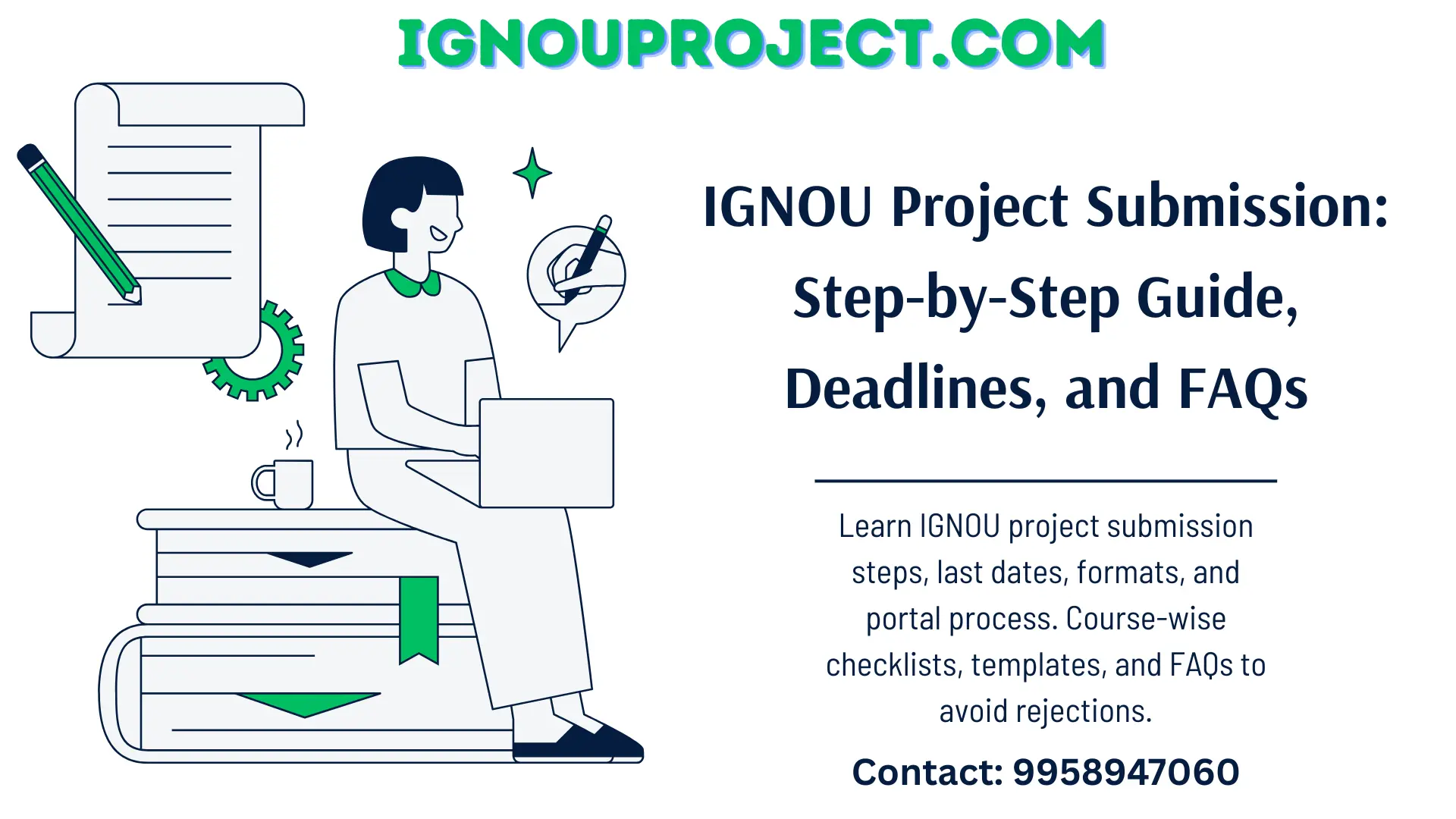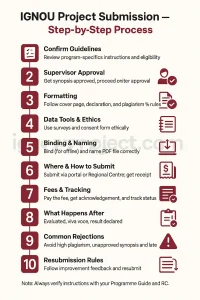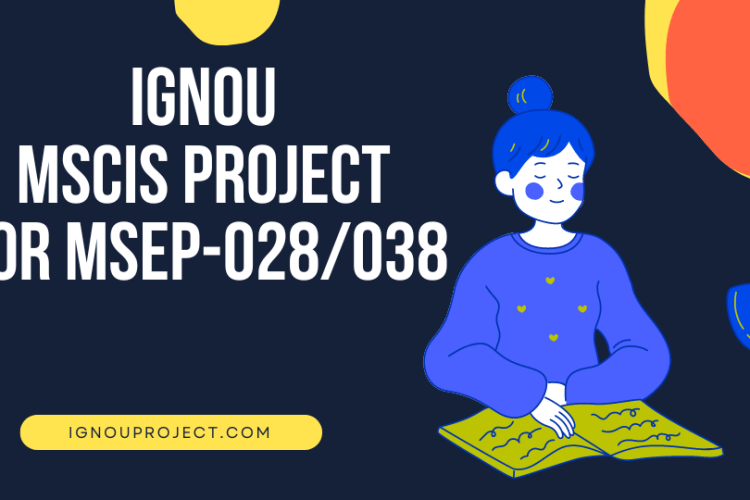
Indira Gandhi National Open University (IGNOU) requires many students to complete a final project or dissertation as part of their degree. Successful IGNOU project submission involves more than just writing the report—it means following specific guidelines, meeting deadlines, and undergoing evaluation. This comprehensive guide breaks down what “IGNOU project submission” entails and provides a practical step-by-step roadmap so you can submit your project confidently and on time.
Quick Summary: In IGNOU, you must get your project synopsis approved before writing the report. Follow the official format strictly (cover page, certificates, etc.) and ensure your work is original to avoid plagiarism issues. Submit the project by the deadline (around May 31 for June cycle or Nov 30 for December) via the online portal (or at your Regional Centre if needed). After IGNOU Project submission, you’ll have a viva voce at the Regional Centre, and your final result (project marks) will be declared along with the term-end exam results.
What “IGNOU Project Submission” Actually Means
In IGNOU, “project submission” refers to completing and turning in the final project or dissertation required for your program. The process includes getting your project proposal (synopsis) approved by the faculty, then carrying out the project work and writing the report following IGNOU’s format, and finally submitting the report for evaluation. After project submission, you also have to attend a viva voce (oral defense) at the Regional Centre to answer questions about your work. All of these steps are part of the IGNOU project submission.
IGNOU Project Submission — Quick Steps (Summary)
- Plan & Approvals: Check your program’s project guidelines and ensure you’re eligible. Pick a topic and get your synopsis approved by IGNOU (through your Regional Centre/School).
- Research & Write: Complete the project work and write the report following IGNOU’s format (cover page, chapters, etc.). Keep it original and avoid plagiarism.
- Documentation: Get your supervisor’s signature on the project certificate and sign the student declaration of originality. Pay the required project fee and attach the receipt.
- IGNOU Project Submission: Submit the final project (with all required documents) via the online portal or at your Regional Centre before the deadline. Obtain an acknowledgment (online confirmation or stamped receipt).
- Viva & Result: Attend the viva voce as scheduled to defend your project. Then check your grade card for the project marks when results are declared.
Detailed Step-by-Step Process in IGNOU Project Submission
Step 1 — Confirm Course-Specific Guidelines
Start by reading the IGNOU project guidelines specific to your course/program (these are usually provided by IGNOU in a programme guide or online). The guidelines outline the required format, structure, and length of the report for your course. Knowing these rules (like word count limits or required sections) before you begin will save you from having to redo work later.
Step 2 — Supervisor Approval & Certificate
Identify a qualified project supervisor (guide) and discuss your topic. Then prepare a short synopsis (project proposal) and submit it to IGNOU (via your Regional Centre or the relevant School) for approval. Do not start the full project until you receive this approval.
After completing your project work, get your supervisor to sign the official certificate of supervision (to be included in your report) and complete the student declaration of originality. These must be part of your final project report.
Step 3 — Formatting (Cover Page & Originality)
Follow IGNOU’s prescribed project format for the project report. It should start with a proper cover page (with title, your details, program, etc.), followed by the supervisor’s certificate and your declaration, then the content (acknowledgements if any, table of contents, chapters, conclusion, references, and annexures). Use the recommended layout (margins, font, spacing) and include page numbers.
Ensure your work is original – aim for a low plagiarism similarity percentage (IGNOU doesn’t specify a number for coursework projects, but under 20% is a good benchmark). Cite sources properly and include the originality certificate with signatures to affirm the work is yours.
Step 4 — Data, Tools & Ethics
If your project involves surveys, interviews, or experiments, make sure to follow ethical practices. Obtain consent from participants (include a sample consent form in your annexures) and maintain confidentiality (don’t use real names in your report). Use appropriate tools for data collection and analysis (e.g., questionnaires, software) and mention them in your methodology. Put lengthy raw data, questionnaires, or transcripts in the annexures rather than the main text, and summarize the findings in your report. This shows you handled data properly and transparently.
Step 5 — Binding & PDF Preparation
Prepare your project for submission. If you are submitting a hard copy, print and bind the report (spiral or soft binding) so it’s secure. Make sure all pages (including the signed certificate, declaration, and annexures) are included in order.
For online project submission, scan all pages and merge them into one PDF file. The scans should be clear and upright. It’s a good idea to name the file clearly (like EnrollmentNo_ProgramCode_Project.pdf) unless IGNOU specifies a format. Always double-check the entire PDF to ensure nothing is missing or out of order.
Step 6 — How & Where to Submit
IGNOU mainly accepts projects through the online portal. Visit the official project upload link (as announced by IGNOU), fill in your details, upload the PDF of your project, and submit. Save the confirmation message or email you receive.
If you are submitting a hard copy at the Regional Centre, take the bound report to the designated counter. Get an acknowledgement (a stamped receipt or signature on a copy of your cover page) as proof of your IGNOU project submission.
In both cases, submit before the last date. Keep your confirmation or receipt safe.
Step 7 — Fees & Tracking
Ensure you have paid the project evaluation fee (₹300/₹500 as applicable) for that term. Include the fee receipt in your ignou project submission (or upload, if online). If the fee isn’t paid, the project won’t be evaluated.
After IGNOU Project Submission, keep your acknowledgement safe. Then it’s a waiting game – evaluation may take a few weeks or a couple of months. You can check the IGNOU assignment/project status online or see if your project marks appear in your grade card (on the IGNOU website). The project result is usually reflected in the grade card when ready. If results are out and your project is still not updated, contact your Regional Centre or IGNOU’s evaluation division for assistance.
Step 8 — Evaluation, Viva & Results
Once submitted, your project is assessed by an IGNOU evaluator. You will then be invited for a viva voce (oral defense) at your Regional Centre (in-person, usually 10–30 minutes). During the viva, be prepared to answer questions about your project’s content, since it confirms you did the work and understand it. Attending the viva is mandatory – skipping it means your project won’t be completed.
Your final result combines the project report evaluation and the viva performance. The marks/grade for your project will be published with the term-end exam results (check your grade card for the update).
Step 9 — Common Rejection Reasons & Fixes
Projects can be rejected or asked for resubmission if you overlook key requirements. The most common issues are: high plagiarism (copy-paste content), not following the prescribed format or missing vital sections (like no cover page or no signatures), submitting without synopsis approval, turning it in late, or using an unqualified guide (or missing the guide’s certificate). How to avoid these? Ensure your work is original (use plagiarism checks and include the originality certificate), stick strictly to IGNOU’s format and checklist, get your synopsis approved beforehand, never miss the deadline, and only work with an eligible supervisor who signs all required documents. By covering these bases, you greatly reduce the chance of rejection.
Step 10 — Resubmission Rules & Timelines
If your project doesn’t pass or wasn’t approved, you can resubmit in the next available Term-End Exam cycle (or a later one within your program’s validity period). Remember: you’ll likely need to pay the project fee again and adhere to the new deadline. In many cases you can revise your existing project rather than start from scratch—just be sure to fix the issues noted (whether it’s content improvements or adding missing documents).
However, if you change your topic or guide, you must get a new synopsis approved. Also, if your program registration is about to expire, secure an extension so you’re eligible to submit. By addressing the feedback and following the resubmission procedures, you have a strong chance to clear it on the next attempt.

Figure: Step-by-Step Process of Project Submission in IGNOU
Course-Wise Notes (Quick Reference)
- MBA / MBAFM / MBF: Management programs with a project (usually 6–8 credits). Expect ~100 pages; topic must relate to your specialization (HR, Finance, etc.). These use project codes like MMPP-001. Work under a qualified guide and be ready for a thorough viva on your business analysis. For ignou project submission rules and step-by-step assistance in MBA, refer to our article: “IGNOU MBA Project Report (MMPP-001): Format, Topics & Submission Guide”.
- MCOM / MA Programs: Many MCOM and M.A. programs (like MA Education, MSC Environmental Studies) include a 4–8 credit dissertation (~50–100 pages). For example, MA Education uses project code MESP-001. (Some MAs like English, History have no project.) These projects are academic research studies and will have a viva focusing on your findings. For IGNOU project submission rules and step-by-step assistance in MCOM, refer to our article: “ IGNOU MCOM Project for MCOP 001 – Complete Guide to Topics, Synopsis, Format & Submission”.
- MSW / MAPC / MLIS / BLIS: These professional courses all have project components tied to practical work. MSW involves a report based on fieldwork (social work case studies); MAPC (MA Psychology) requires a research project in your specialization; MLIS has a project (e.g., MLIP-002) on library/information science; BLIS includes a smaller practical project. Expect a viva that tests how you applied theory to practice.
- Undergraduate Projects: Some bachelor’s and diploma programs (e.g., BBA, DNHE, BTS) require projects, though on a smaller scale. BBA might have a 40–60 page project (often an internship report or case study). DNHE may involve a short community nutrition project. BTS includes a tourism case study project. These are shorter but still must follow IGNOU guidelines.
Last Dates & Calendar (Current Session)
| Term-End Exam Cycle | IGNOU Project Submission Deadline |
| June TEE (for January session students) | May 31 (same year) is the typical last date for project submission (for the June exam cycle) |
| December TEE (for July session students) | November 30 (same year) is the typical last date for project submission (for the December exam cycle) |
Note: These deadlines can change slightly each year. IGNOU often extends the dates (e.g., a May 31 deadline might be extended to June 15). Always double-check the official IGNOU announcements for the most current deadlines in your academic session.

Figure: Project Submission Deadlines in IGNOU
IGNOU Project Submission — FAQs
Q: What is the last date for IGNOU project submission?
A: Usually around May 31 for the June TEE cycle and November 30 for the December TEE cycle. Always check the official IGNOU announcement for the exact deadlines each session (they can change).
Q: Can I submit my IGNOU project online?
A: Yes. IGNOU has an online project submission portal where you can upload your project report PDF. Follow the instructions on the portal and submit before the deadline. Save the confirmation message as proof.
Q: Is there any fee for IGNOU project submission?
A: Yes, there’s a project evaluation fee (around ₹300–₹500 depending on the project). You typically pay it with your exam form. Make sure to pay it and include the receipt with your project.
Q: What if my project synopsis is not approved?
A: If your synopsis is rejected or needs changes, you must revise it (or create a new proposal) and submit it again for approval. Don’t proceed to write the full project until you have the official synopsis approval from IGNOU.
Q: How do I know if my IGNOU project submission was received?
A: The online portal shows a confirmation message or sends an email if you submitted successfully. For hard copy submissions, the stamped receipt from the Regional Centre is your proof. You can later verify via your grade card or the status portal that your project was recorded.
Q: Is viva voce mandatory for IGNOU projects?
A: Yes, almost always. For any program that includes a project, you are required to attend a viva voce (oral defense) at the Regional/Study Centre. Skipping the viva usually means your project will be marked as incomplete or failed.
Q: What is the difference between a synopsis and the project report?
A: The synopsis is a short proposal of your project (explaining your topic, objectives, and method) that you submit for approval first. The project report is the full detailed study you conduct and submit after the synopsis is approved.
Q: How much plagiarism is acceptable in the project?
A: Aim for very low similarity (ideally under 20%). IGNOU expects original writing and can reject work that shows excessive copying. Always paraphrase content and cite your sources properly.
Q: Can I change my project topic or guide after approval?
A: Not without fresh approval. If you have to change your topic or supervisor after your synopsis is approved, you’ll need to submit a new synopsis (with the new topic/guide details) and get it approved by IGNOU.
Q: How do I check my project result or status?
A: You can check your project marks in the IGNOU Grade Card on the official website – once your project is evaluated, the grade/marks will appear there. Additionally, IGNOU may update a project status on its portal, or you can inquire at your Regional Centre. Final project results are usually released along with the term-end exam results.
Download: Ultimate IGNOU Project Submission Checklist (PDF)
We have prepared an IGNOU Project Submission Checklist (in PDF) that you can download for a quick reference. It summarizes every step and required document discussed above in a handy tick-mark format. Use this checklist before submission to make sure you haven’t missed anything important. Feel free to download and print it out for your convenience. Click here below to download additional resources for IGNOU project submission checklist:
- IGNOU MBA Project Submission Process
- IGNOU MCOM Project Submission Process
- FAQs on IGNOU Project & IGNOU Synopsis
- IGNOU Synopsis Sample PDF
- IGNOU Project Sample PDF
- IGNOU MBA Project Guidelines
- IGNOU Project Viva Questions
- IGNOU Assignment Submission
Conclusion – Final Words
IGNOU project submission is a significant milestone in your academic journey. It might seem daunting at first, but by following the guidelines step by step and staying organized, you can avoid common pitfalls. Remember to start early, adhere to the format and deadlines, and maintain originality. With thorough preparation – and by using resources like this guide and checklist – you can confidently complete the IGNOU project submission process and move closer to earning your degree. Good luck!

